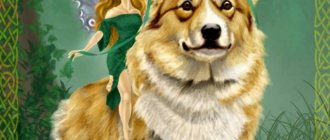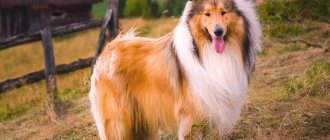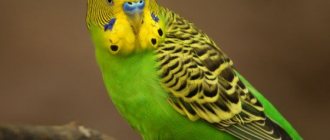Saint Bernard is a friendly giant with an affectionate character and a slightly sad look. They are calm and at the same time very energetic dogs. Today, the Saint Bernard is distinguished by two types of coat: short-haired and long-haired. Considered to be an excellent family dog. With the right training course, he can become an excellent rescuer.
- Country of origin : Switzerland
- Height at withers : male: 70–90 cm, female: 65–80 cm
- Weight : 50-90 kg
- Lifespan : 7-11 years
- Use : companion dog, rescue dog, draft dog
- Other names : Alpine Mastiff
History of the breed
The Saint Bernard was developed in Switzerland along with several other breeds, including the Bernese Mountain Dog, Entlebuch Cattle Dog, Appenzell Cattle Dog and Greater Swiss Mountain Dog.
They were most likely crossed with mastiff-type dogs that came with the Roman army during the time of Emperor Augustus. By the first millennium AD, dogs in Switzerland and the Alps were grouped together and known simply as Thalhund (valley dog) or Bauernhund (herding dog).
The Saint Bernard Pass is the most famous and treacherous alpine pass, located at approximately 8,000 feet above sea level and can only be climbed between July and September. Today here you can see the remains of the great Roman road, as well as traces of Napoleon's crossing.
Archdeacon Bernard de Menton arrived at this pass, which would later be named after him, in 962 AD, and there he founded his monastery, which helped travelers who crossed this treacherous pass.
It is unclear when these dogs were first used at the monastery, but a painting of well-built, short-haired dogs that closely resembled St. Bernards in their current form was painted in 1695. The first written mention of this breed in records dates back to 1703.
The dogs were used by the monks of the monastery to guard the territory. When the monks went in search of lost travelers, they took dogs with them for protection and accidentally discovered that they were excellent trackers, capable of finding helpless travelers. The dogs had good health, could withstand harsh winters and had excellent physical characteristics. All this was useful for search and rescue operations.
During the three centuries during which the monastery kept its records, the St. Bernards were credited with saving more than 2,000 travelers. By the 1800s, dogs had no official name, although they were well known. Between 1800 and 1810, a dog named Barry saved 40 people and became one of the most famous dogs to ever live.
Breed standard
Saint Bernard belongs to the large breeds of the raw type. These are powerful animals, they come in soft-haired and hard-haired varieties. The weight of adults is about 70 kg , height is 70-90 cm .
A large head rests on a powerful neck with a slight dewlap. The skull is short, the forehead is convex. Small, medium-length, drooping ears. Brown eyes, not deep set, slightly sunken. Eyelids are damp. The muzzle is short, with a blunt bridge of the nose. The nose is wide, black in color with flat nostrils. The jaws are massive.
The physique is powerful, the back is wide. The limbs are widely spaced, muscular and straight. The paws are massive, with arched toes. The tail is weighted and long. In a calm state, the dog keeps it lowered down; in an excited state, he twists it up.
There are two types of St. Bernards based on their coat type: long-haired and short-haired:
1. Long-haired – the coat is long and soft. Light curls are allowed at the bottom. There is a thick undercoat. “Pants” and “skirt” of medium length. A characteristic feature of the breed is the fluffy collar. The hair on the face and ears is shortened. 2. Short-haired - the coat is short, the guard hair is hard. There is a dense undercoat.
The color is red and white or white with red spots. According to the standard, any shade of red is allowed.
Saint Bernard: features of the breed
- The Saint Bernard is a giant breed, and although they are usually quiet and calm, they are not suitable for apartment living. They are comfortable in a private house with a large plot.
- Saint Bernards drool, especially when eating, so it is recommended to carry a handkerchief with you to wipe your pet's mouth.
- They shed twice a year. During shedding, the coat needs to be brushed daily.
- The eyes periodically water, so they require wiping.
- Frequent and long walks are a must.
- Late maturation.
- The Saint Bernard is an excellent family dog, but is not suitable for families with very young children. Because given the size of the dog, he could inadvertently push the child.
- Originally bred to withstand the cold temperatures of the Alps.
- Does not tolerate heat well.
- They are not famous for barking for no reason.
- Unfortunately, St. Bernards do not live long - from 7 to 11 years.
- It can warn of danger and even take action. However, this breed is not a guard breed, it is a rescue breed. Their main role is to help people, not to detain them.
Character and appearance
The character of the animal is good-natured, calm, balanced. It's not scary to leave him with small children, other pets, or people. If there is insufficient communication with the owner, the dog becomes depressed: it becomes sad, it hurts itself.
Saint Bernards are not characterized by aggressiveness or cruelty. They can even bark only in some cases, when their home is in danger and there are good reasons for this.
Dogs of this breed understand their owner instantly, predict his mood, and do not cause trouble. In all actions there is a desire to please, to receive praise and approval.
Externally, there are 2 types of individuals: short-haired St. Bernards and long-haired ones. They are harmoniously put together:
- big head;
- muscular strong body;
- majestic, even threatening appearance;
- large size and significant growth.
They have a short muzzle with a slightly upturned nose, triangular, slightly rounded drooping ears and expressive, kind eyes.
Health
Like any other breed of dog, St. Bernard is prone to certain diseases:
- dysplasia of the hip and elbow joints,
- dislocation of the kneecap;
- osteosarcoma;
- eye diseases.
Preventative measures to protect your St. Bernard puppy
- To keep your St. Bernard puppy completely safe, you first need to minimize his contact with unfamiliar dogs, especially strays. Therefore, you should not let your dog off the leash, as in this case it will become impossible to control its behavior and communication with other dogs. Since a dog can easily become infected with distemper from simply touching the nose of a sick animal. This disease can be transmitted to a dog through sniffing. Your dog can become infected with trichophytosis from contact with the lichen-affected fur of a sick dog. Naturally, it is impossible to completely exclude a dog’s communication with other dogs, since it must be socialized. Therefore, try to find friends with dog lovers who look after their animals. By adhering to this rule, you can eliminate the risk of pathogen transmission by 80%.
- You should walk your dog in places where there are no landfills. Since garbage very often attracts rodents, which in turn are very often carriers of various infections. Gray rats are especially dangerous because they carry such a serious disease as leptospirosis.
- You should not allow your dog to sniff other people's feces, as they are a source of worms.
- Monitor the well-being of your St. Bernard. Pay attention to even the most minor changes in his behavior. For example, your dog may appear lethargic, lose his appetite, or have a dry nose. Or you may notice that the dog begins to shed, and this has nothing to do with seasonal shedding. If hair loss becomes excessive, this is the first symptom indicating health problems in your pet. And only you can help him. Therefore, it is important to take the dog to the veterinary clinic in time, where the disease can be overcome for sure. In no case should you ignore the symptoms, since advanced infections are much more difficult to treat, and sometimes even impossible. If you start treating your dog, the disease can lead to his death or he will develop serious complications that will affect his hearing, vision, limbs and much more.
Standard and characteristics of the St. Bernard breed
The Saint Bernard has a rectangular constitution, i.e. his body is longer than the height at the withers. The Saint Bernard's bones are stronger than those of all other dogs.
Learn more about the standard of the St. Bernard breed and its characteristics.
The muscles are strong and at the same time long. Hence the exceptional strength of his muscles, which is combined with great mobility.
The impressive size of the head perfectly expresses all the strength and nobility of this giant among dogs. The head is angular, with prominently protruding bones. Its length is about 36% of the height at the withers.
A characteristic feature of the breed is the convergence of the longitudinal upper axes of the skull and muzzle. The zygomatic arches protrude strongly outward. In the front part of the skull, the tubercles are well defined, the ocular arches are no less clearly defined, as a result of which the transition from the forehead to the nose forms a right angle. The skull is very wide. In males it is wider than it is long. The length is 64% of the length of the entire head.
The muzzle is exceptionally thick. Its length is 34% of the length of the entire head. The nasal canal is straight, very wide, flat. The nose is thick with wide nostrils and completely black. The muzzle in front is flat and wide, cube-shaped. The lips are large and thick. The jaws are massive and curved. The bite is pincer-shaped, scissor-shaped. The teeth protrude slightly forward. The incisors form a straight line.
The ears are medium in size, hanging, set high, wide at the base.
The eyes are of medium size, moderately sunken. They are located in a subfrontal position, hence the look as if from under the forehead. Color – dark brown.
The chest is highly developed in all three parameters, which is quite natural for such physical strength. The chest is lowered in the area of the elbows. The spine is straight, the withers are long and strongly raised, the loin is short, the croup is horizontal, which is typical for all mountain dogs.
The limbs are very strong, long and muscular. The paws are wide and rounded.
The angle of the shoulder with the humerus is noticeably emphasized. While the ankle angle is quite moderate, which is also typical for all mountain dog breeds.
The tail is set high, thick at the base, very heavy and long.
The coat of individuals with the so-called short coat has a moderately short length - up to 5 cm. Well-fitting, thick, dense, but not coarse. In individuals with long hair, it has an average length - up to 8 cm. The typical color is white-red or red-white. Wool of variegated color, where it is predominantly white, should not have specks or spots of a darkish color. The collar, nose trunk, dewlap, paws and tip of the tail must be white.
The Saint Bernard is a large breed of dog and is distinguished by its maximum height, impressive appearance and aristocratic posture. Provided by the standard
height is at least 70 cm at the withers for a male and at least 65 cm for a female.
These values are clearly too low, since, in theory, the absolute minimum should be 78 - 80 cm for males, and 70 - 72 cm for females. However, in the homeland of St. Bernard dogs - in Switzerland - such values were rejected, since the dogs there are actually shorter in stature and Swiss dog breeders simply could not agree to such a “standard”.
Fortunately, the standard does not provide for maximum height and, in addition to the St. Bernard, this applies to two more breeds of dogs - the Great Dane and the Irish Wolfhound (Irish Wolfhound), which have the same height as the St. Bernard. There were specimens 90 - 100 (!) cm tall. One of them, 96 cm tall, was distinguished by such a harmonious physique and moved so well that in the 70s he regularly became a champion of exhibitions.
The Italian variety of St. Bernard is distinguished by its largest size, and therefore is in demand abroad, in particular in Germany, Denmark and Switzerland, where they are used to improve breed characteristics. It is quite obvious that such a characteristic as large stature should be proportionally combined with a harmonious physique, a typical head and functional qualities. However, we have already seen that the gigantic size was a necessary prerequisite for effective rescue work in the mountains, and, therefore, is in full accordance with the purpose of the breed.
Unfortunately, these giants are not known for their longevity and they do not tolerate heat well.
The weight of individuals with maximum growth can reach, and even exceed, 100 kilograms.
The weight of a Saint Bernard at birth ranges from 800 grams to 1 kilogram. During the first week, the weight doubles, and by the end of the first month it reaches 4 -5 kilograms, by the end of the second 10 - 15 kg, the third - 20-25 kg (!). By the end of the first year of life, weight can exceed 80 kg. And in a mature individual, as stated above, it weighs 100 kg.
Did you like it? Share with your friends!
Give it a like! Write comments!
Training and education
Saint Bernards are smart dogs, but their phlegmatic temperament can hinder them during the training process. All commands are carried out slowly, there is no need to rush him. Over time he will pick up the pace. This must be taken into account when training. Submitting a dog doesn't always work. The principle of complete subordination of the St. Bernard to the owner is an outdated method. This theory was formulated based on observations of packs of wild wolves, but they were kept in captivity and, of course, experienced stress. The stress condition forced wolves to show aggression towards each other, but in the wild they do not show aggression to each other - they live together and interact with each other. You need to perceive yourself as the more experienced and mature member of the pack, who is responsible for guiding the new member (St. Bernard puppy) and teaching him good behavior, as well as correcting him if necessary. It is important to remember that St. Bernard puppies learn a lot on their own. They are very inquisitive, love to explore new territories and, of course, experiment. Puppies tend to repeat actions they enjoy (like playing with a toy). They do not repeat actions that cause them pain (for example, destroying a nest and getting bitten). If your St. Bernard puppy misbehaves, ignore him and praise him when he does the right thing. Reward your puppy for following commands and good behavior. Do not neglect these tips. After all, constantly hearing “you can’t” all day long is unbearable. This is a small child who wants to know everything and get his portion of treats as a reward for not eating your favorite rug, going to the toilet outside, bringing you a ball, and so on.
Set rules and monitor their implementation
It is worth enrolling your St. Bernard puppy in obedience training classes. These classes will allow you to understand exactly what actions will allow you to control your dog’s behavior. You will be able to spend more time with your puppy, establish contact and socialize around other dogs.
Adviсe
- Training a St. Bernard puppy should be done with the help of positive motivation; watch carefully special films about this technique. The Canine Translator film series from National Geographic is suitable.
- If you need to leave your puppy at home alone for 2 hours or more, then ask someone to come to him.
- Be sure to schedule your St. Bernard puppy an appointment with the veterinarian as soon as possible. The doctor will carefully examine him and give him vaccinations that will protect him from dangerous diseases.
Advantages and disadvantages
The main advantage of the breed is its character: completely non-aggressive, hardy, patient. It has good watchdog potential, which allows it to be kept in the house for protection.
Individuals are unpretentious in care and nutrition. St. Bernard puppies and larger representatives are distinguished by above average intelligence and easy learning ability.
Basically, by nature, dogs are slow and phlegmatic. However, a completely different temperament may appear from upbringing and genes. The disadvantage of the breed is the need for a large space and mainly outdoor maintenance. The apartment is cramped for the dog.
Other disadvantages of St. Bernards:
- heavy shedding;
- constant drooling;
- food and maintenance require high expenses;
- the need for training, taking a socialization course and mastering the basic rules of behavior in public places;
- hereditary diseases.
Attitude towards children and pets
Patient and gentle, they carefully let children put up with a lot. Always supervise any interactions between dogs and small children. Teach your child never to approach any dog while it is sleeping or eating, or to try to take food from it. No dog should be left unattended with a child.
They get along well with other pets, especially if they were introduced to them as puppies. However, this giant dog breed may accidentally step on or push your small pet.
A good nursery, how to choose one
A specialized nursery is the best place to buy a good St. Bernard puppy. If pedigree and thoroughbred are important, then it is better to hire an experienced dog breeder to help. If not, then you can trust your heart. On nursery websites, there are customer reviews that will help you navigate. A little secret or life hack: visit a dog show where the desired breed will be presented. Chat with the owners of the breed, ask about the nuances, find out where they purchased the puppies. True dog breeders live for their pets, so they will be happy to answer any question and give valuable advice. Typically, nurseries send their representatives to exhibitions, where there is a chance to meet in person and take a business card.
History of the origin of St. Bernard
There are several versions of the appearance of St. Bernards. Some dog experts believe that the dogs are descended from Dogues de Bordeaux (dogs of Roman legionnaires), and acquired the final standard after crossing with Newfoundlands. Others believe that the ancestors of the St. Bernard were Tibetan mastiffs, brought to Europe and crossed with local breeds.
The name of the breed was given by the monastery of St. Bernard in the Alps, created in the 11th century. Large, strong and hardy dogs lived at the monastery and helped find lost travelers in the mountains. Dense, thick hair and excellent sense of smell allowed the dogs to find people even under avalanches, and thanks to their strength, St. Bernards successfully delivered frozen travelers to the monastery.
In the 19th century, European cynologists began breeding animals. The breed began to acquire standards similar to modern ones.
How to choose a strong and healthy St. Bernard puppy
The day has come to go to the nursery for a cute puppy. Babies should be kept in a clean enclosure, without a specific unpleasant odor, which is very important. First of all, the breeder will demonstrate the numerous awards that his pets have received. Listen carefully, but don’t be easily fooled by all the big titles and championship accolades. If possible, you need to look at the parents of the future pet. The main 10 signs that will help you choose a healthy St. Bernard puppy:
- shiny and moist nose;
- clean ears, pink;
- lively, clear look;
- clean eyes, without any discharge;
- full number of teeth and correct bite;
- healthy skin, without parasites, sores and acne;
- silky, shiny coat;
- lymph nodes of normal size;
- the tail is without creases or docked;
- no bloating.
A good proof that the animal is healthy is a written document of purchase and sale. If the St. Bernard puppy develops abnormalities over time, according to the contract, the pet can be returned. Having “insurance” with the buyer will reduce the risk that the seller will slip in a problem animal.
Age for adoption
- Professional Russian dog breeders advise buying 8-10 week old puppies. At this age, the baby should already be vaccinated, toilet trained, and receive basic education.
- An important point: it is not recommended to take a puppy home immediately after separation from its mother. Until 9 weeks of age, the baby learns dog language and learns to communicate with its own kind. He needs to spend several weeks in a doggy daycare.
- A professional breeder knows that a St. Bernard puppy that is less than 6 weeks old cannot be given away. A very small puppy can only be given to an experienced owner who knows how to raise it correctly. This option is not suitable for a beginner.
- Depending on the breed, the puppy can be picked up earlier or later than 10 weeks of age. Large dogs grow more slowly, so it is recommended to remove them from kennels at the age of 3 months. Puppies of such breeds should gradually build up bone and muscle tissue, without sudden jumps, in order to avoid problems with the musculoskeletal system.
- For St. Bernard puppies of show or breeding class, the age of “adoption” can only be 6-9 months. This is a mandatory condition, because it is at this age that the makings of a champion and the distinctive signs of thoroughbred are revealed. You need to have patience to get a future titled champion.
Note : even the most expensive St. Bernard puppy cannot with a 100% guarantee become a champion. The breeder’s job is to assess the potential and make a forecast. Next, you need to raise the puppy and train it for a long time in order to realize the makings of a champion.
Education and training
Saint Bernards are smart, quick-witted, and amenable to training. It is important to choose the right methods for this, taking into account the characteristics of the breed, their slowness, and the desire to please the owner.
At home, when training a St. Bernard, it is important to build a respectful, trusting relationship with the dog, to exclude violence and cruelty for disobedience. The puppy must be accustomed to the toilet and its name from the first days of its arrival in the house.
The Saint Bernard is a friendly, slightly touchy, depressed breed. This dog should not be kept on a chain, left alone for a long time, or violence should be used against it. Such measures will cause her apathy and disappointment in the owner.
You need to walk your dog for 2-4 hours, depending on age, during the daytime and in the evening, with the exception of summer with sultry heat. She not only needs to breathe air, but also actively play, run, walk, and follow commands.
When buying a puppy, it is important from the very first day to accustom him to a place to sleep, eat, and basic commands. If the dog has done everything correctly, reward him with treats and affection. When training experience is not enough, it is advisable to undergo training from a professional dog handler.
Documentation
- A St. Bernard puppy has a mark in the groin area or it may be on the ear, as well as a puppy card (metric). The codes on the card and on the stamp must be identical.
- Metrica is the primary document that is issued for a puppy when it reaches the age of 45 days. Next, a qualified dog handler examines the babies and notes any defects found. The owner of the dog, if desired, can change the metric to a new document, pedigree, at the age of 6-15 months. This document will allow the pet to participate in breeding.
- Another document for the puppy is a veterinary passport, with mandatory vaccination and deworming notes. When the documents have been checked and everything is in order, you need to ask the breeder in detail. Take his number, at first a lot of questions will arise, especially for new dog breeders.
Maintenance and care of St. Bernard
Saint Bernard needs a permanent place . Prepare a trestle bed with bedding or a thin mattress for him in a quiet place. The animal should not lie down on beds, sofas or chairs.
Long-haired dogs need to be combed once every 1-2 days. After walks, St. Bernards wash their paws; in urban conditions, it is better to protect the pads with a special ointment. If the dogs are heavily soiled, bathe them with a mild pet shampoo.
The eyes should be wiped daily with a swab dipped in cold boiled water or a special lotion.
It is better to feed the dog from a bowl mounted on a high stand. The animal needs walks 2-3 times a day , preferably at a calm pace. Trips to nature, where the St. Bernard can run or swim, are useful.
Interesting facts about St. Bernards
- It is impossible to name the exact ancestor of the breed; there is a lot of disagreement on this matter. Cynologists argue to this day where the St. Bernard breed came from. It is known that the country of origin is Switzerland, but no one knows for sure which breeds were selected for selection. According to experienced dog handlers, the ancestor of the big red-and-white dogs was the Tibetan Great Dane. There is also an opinion that to breed St. Bernards, mastiffs and Great Danes were crossed.
- A special feature of St. Bernard training is the ability to work in pairs. They went in search of a person, then dug him out of the snow, after which the female remained to warm the frozen one, and the male went to people for help.
- The breed was named after the monastery of St. Bernard, located in the Alps.
- The dog breed is often found in cartoons and movies, and in leading roles. St. Bernards gained particular popularity because of the film “Genevieve,” as well as the TV series “Hopper,” and of course, who doesn’t remember the movie “Beethoven.”
- There were always dogs of this breed in the monastery, because they constantly helped to rescue people caught in a snow blockage or an avalanche. Only rough estimates indicate more than several thousand saved.
- A documented case where St. Bernard Barry helped 40 people who were captured by the elements. These were isolated cases recorded between 1800 and 1812. The dog helped them find their way to the monastery without freezing or getting lost. There was also a case when Barry carried a boy on his back for 5 km. He found the child in the snow and independently decided to take him to the people. Since that time, the most beautiful and strong puppy from the litter receives the nickname Barry. The dog rightfully deserved a monument that grateful people erected to him.
- From cartoons and movies, you can see that St. Bernards must have a barrel on their neck. There is constant controversy surrounding this “accessory”. According to the legend, brandy was poured into the container so that a person dug out from under the snow could warm up and find the strength to reach the shelter. True, it is much more prosaic, because the barrel is the fiction of Edwin Landseer. The artist painted canvases with alpine landscapes and handsome St. Bernards, and a small barrel became their highlight.
- However, today, St. Bernards do not go to work empty-handed. Not with a keg, of course, but with a modern first aid kit and a small supply of provisions and water.
- Huge and at first glance scary St. Bernards, but in fact not at all aggressive. In the “kindest breed” category, they can easily count on a prize. Aggression on the part of a St. Bernard is a very rare occurrence.
- Due to the characteristics of the breed, they grow very quickly, but remain playful like a puppy long after they grow up. Even a very large dog can behave “like a child.”
- A significant disadvantage of the breed is its short life expectancy compared to other breeds. Even with excellent care and good health, St. Bernards rarely live to the age of 9-11 years.
- If you need a versatile dog, then the St. Bernard will be the ideal choice. He can become an assistant, a friend and a good listener. The Saint Bernard will reliably protect the house, and if necessary, can save the life of its owner.
If you decide to get a dog, then get ready for the following: you will often have to clean up little mistakes after your puppy; investments will be required in annual vaccinations, feeding, toys, ammunition, etc.; any animal requires attention and communication, so if you don’t have time, then there will be no mutual understanding with the St. Bernard puppy. Big changes are coming in your life. If you can handle this, you will find a loyal friend for life.
Care and maintenance
Due to its size (it is one of the largest dogs in the world), the St. Bernard requires a large living space, so it is best to bring this breed into a private home. The dog's coat is very warm, it allows its owner to live outside and calmly endure frost and bad weather.
For the same reason, in summer it is necessary to protect the dog from the scorching sun and heat. You can bring such a dog into a large apartment if you can provide him with fresh air and regular walks.
Caring for and maintaining a St. Bernard requires regular attention from the owner. Pets with long hair should be brushed every day, and those with short hair – 2 times a week. Bathing with special shampoos and conditioners is necessary when soiled.
An adult dog will not fit in a standard bathtub, so you should think about a place for water procedures.
Shedding is infrequent: 2 times a year. During this time, brush your pet more often.
You should regularly wipe your dog's eyes and mouth due to increased salivation and the appearance of smudges.
To participate in exhibitions, your dog will need to have a professional haircut. A hygienic haircut at home is also suitable for everyday life.
How long do St. Bernards live? Unfortunately, it doesn’t last long - from 8 to 10 years, and this is their main, and perhaps the only drawback...
What to feed a St. Bernard? The puppy's diet should contain a number of vitamins that maintain calcium levels in the body. Food should be natural and fresh. In the sample menu, include about 200 grams of meat, cottage cheese, vegetables, porridge, boiled eggs and sea fish are acceptable, as well as constant fresh water.
The amount of food needed increases as the pet gets older. The main products should be those that contain protein: raw meat, boiled offal, steamed sea fish, various seafood products. Dry food is acceptable at least premium and super-premium class.
Don't forget to give your adult dog bones and cartilage to strengthen his teeth.











